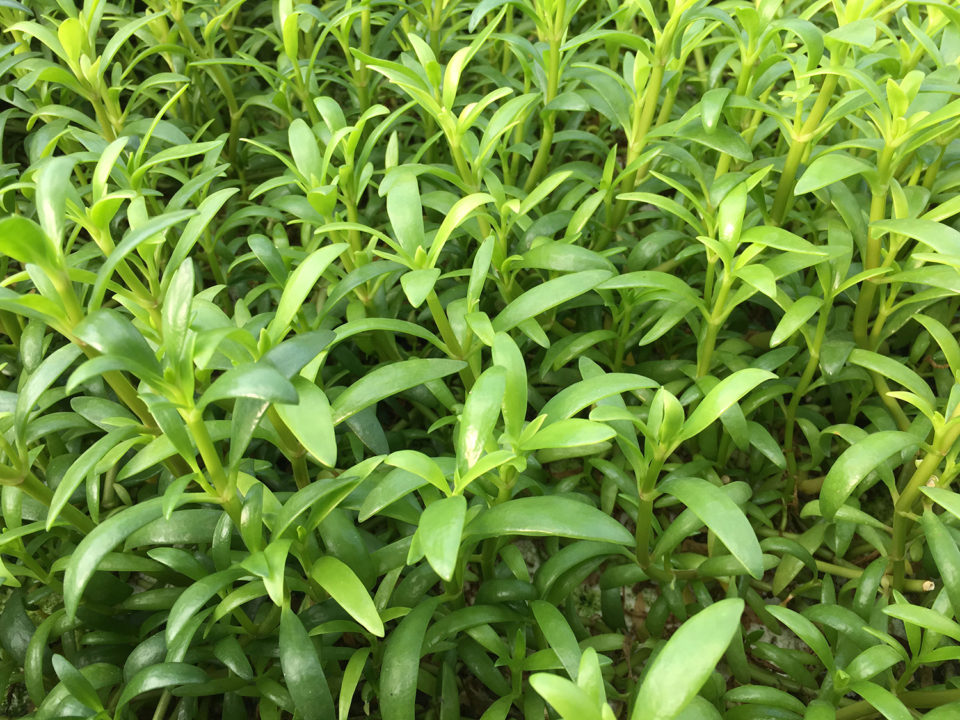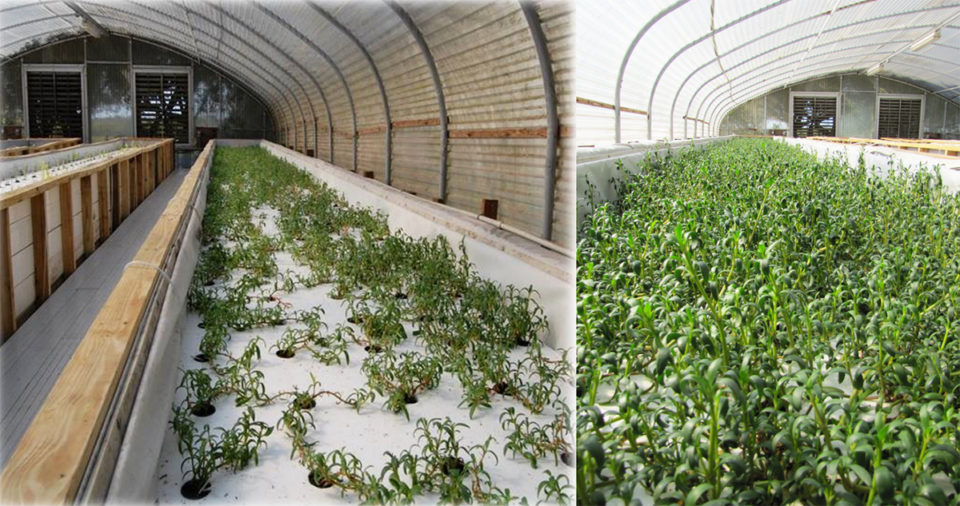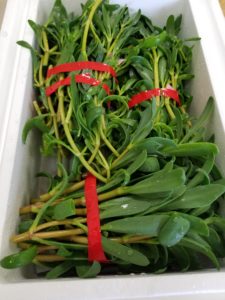Expanding vegetable resources with marine aquaponic systems

Sea Purslane (Sesuvium portulacastrum) is an herbaceous perennial halophyte plant [plants that grow in saline environments] and is found throughout much of the world’s coastal areas – especially on the continents of Africa, Asia, North America, South America and Australia. In North America, sea purslane is found in wet sandy habitats of the southern coastal states, but it has been reported as far north as the Delaware River in Pennsylvania. Sea purslane is not only an edible halophyte plant, but it also helps protect the fragile coastlines and dunes from erosion. Therefore, wild harvest of this plant is strongly discouraged.
Sea Purslane is sold for food and medicinal purposes in markets around the world, especially in small local markets in the Caribbean, Asia, India and Europe. This edible halophyte plant is native to coastal habitats in Florida, and researchers from Mote Marine Laboratory’s Mote Aquaculture Research Park (Sarasota, Fla., USA) are farming sea purslane and redfish (Sciaenops ocellatus) in a brackish water (salinities ranging from 10 to 18 ppt) marine aquaponic system. Marine aquaponic systems can be used to produce halophyte plants that tolerate saline conditions together with fish (aquaculture) in the same aquatic environment.
Health benefits
Sea purslane has many reported benefits. Plant leaves are high in antioxidants, such as beta carotene, and are an excellent source of vitamins and minerals. Table 1 shows the concentrations of vitamins and minerals from samples of sea purslane grown in the Mote Aquaponics system.
Main, sea purslane, Table 1
| Nutrient | Value (per 100 g) |
|---|
Nutrient | Value (per 100 g) |
|---|---|
| Beta carotene | 680 mcg |
| Calcium | 23 mg |
| Magnesium | 49.7 mg |
| Phosphorous | 33.4 mg |
| Sodium | 808 mg |
| Vitamin C | 6.95 mg |
| Vitamin K | 164 mg |
| Vitamin B1 | 0.02 mg |
| Vitamin B2 | 0.06 mg |
| Folate | 17.4 mcg |
| Niacin | 0.24 mg |
| Pantothenic acid | 0.17 mg |
In addition, sea purslane is also known to contain omega-3 fatty acids, surprisingly more than any other leafy vegetable plant. It is an excellent source of vitamin A and rich source of vitamins C, B complex, as well as minerals such as magnesium, iron, calcium, manganese and potassium. Sea purslane has been reported to be an excellent source of protein and dietary fiber. Lastly, oil extracted from sea purslane leaves has also be reported to contain medicinal properties such as being an antimicrobial (antibacterial and antifungal) agent against some tested human pathogenic organisms. As a cautionary note, sea purslane does contain oxalic acid, a naturally occurring substance found in vegetables, such as spinach, beets, rhubarb and kale. People with known oxalate urinary tract stones are advised to avoid eating purslane.
Edibility
Sea purslane can be eaten a variety of ways, including raw or cooked (sautéed, roasted, or steamed). Although the stems near the roots can be tough and should be cut away, the remainder of the plant (stalk and leaves) is very edible. We are also in the process of writing a sea purslane cookbook containing a large number of recipes compiled from local chefs, colleagues and from the internet.
Aquaponics
Mote Aquaculture Research Park scientists began cultivating sea purslane in a sustainable marine aquaponic system in 2014. Aquaponics technology developed for freshwater systems has been adapted to develop a prototype saltwater aquaponic system. Currently, the majority of aquaponics farming is done with freshwater plants and fish, thus creating a real need and opportunity to develop and identify plant crops that will flourish in saltwater aquaponic systems. The combination of purslane and redfish has proven to be a viable option for a successful marine aquaponic system.

Mote’s prototype saltwater aquaponics system not only produces healthy sustainable plants and fish, but this technology and knowledge can be easily transferred to individuals, local communities and businesses that want to produce healthy and sustainable local aquaculture products. In addition, edible sea purslane vegetables have been well received by the community and are successfully sold in local restaurants and farmers markets.

With the right conditions, equipment and knowledge, sea purslane is fairly easy to grow in marine aquaponic systems. Plant cuttings are started in small containers/pots utilizing a coconut husk medium. Plant pots are suspended in a floating raft that keeps the edible part of the plant above, while allowing the purslane roots to access and utilize the nutrients in the water system.
This land-based sustainable aquaculture system links fish tanks and vegetable raceways into one system. Water leaving the fish tanks is filtered to remove solids, after which it enters a biofilter to reduce ammonia and nitrite but is still high in nitrate. After biofiltration, water is UV filtered and then flows through plant raceways, where plants uptake and assimilate additional nitrogen nutrients (especially nitrates) from the water. Water then returns at a higher quality to the fish tanks. This eco-friendly recirculating system is totally self-contained, where the fish provide nutrients to the plants and the plants return clean water to the fish tanks.
Perspectives
Global seafood consumption is on the rise and is predicted to grow at a faster rate in the coming decades. Therefore, aquaculture producers must continue to find ways to provide high quality aquaculture products to meet increasing consumer demand using sustainable, environmentally friendly technologies.
The aquaponic system at Mote Aquaculture Research Park is operated as a sustainable recirculating aquaculture system. A pilot-scale system is under construction to expand both fish and vegetable production. The expanded system will provide opportunities to demonstrate year-round production of high-value seafood products and to expand technology transfer to local farmers that are interested in providing farmed seafood products to local markets.
Now that you've finished reading the article ...
… we hope you’ll consider supporting our mission to document the evolution of the global aquaculture industry and share our vast network of contributors’ expansive knowledge every week.
By becoming a Global Seafood Alliance member, you’re ensuring that all of the pre-competitive work we do through member benefits, resources and events can continue. Individual membership costs just $50 a year. GSA individual and corporate members receive complimentary access to a series of GOAL virtual events beginning in April. Join now.
Not a GSA member? Join us.
Authors
-
Kevan Main, Ph.D.
Director and Senior Scientist
Mote Aquaculture Research Park
874 WR Mote Way
Sarasota, FL 34240 USA -
Thomas Waldrop
Senior Biologist
Mote Aquaculture Research Park
874 WR Mote Way
Sarasota, FL 34240 USA
Tagged With
Related Posts

Responsibility
White House awards hint at aquaculture’s potential in the United States
The latest Champions of Change awards celebrated the work of change-makers in sustainable seafood, from chefs to fishermen to aquaculture advocates. With innovation and perseverance, the industry may soon meet its vast potential.

Aquafeeds
Can corn fuel aquaculture’s growth? Veramaris says yes
The benefits of omega-3 fatty acids to human health are well known. Fish need them too. To supplement current supplies from wild-caught fish, one innovative venture is turning to the corn fields of Nebraska – yes, Nebraska – for answers.

Responsibility
Aquaponic system produces red drum, saltwater vegetable species
A project in Florida is studying the feasibility of a marine aquaponic system containing red drum and two native saltwater species. Water that exits the plant raceways is filtered and recirculated to the fish tanks. In tests, sea purslane grew rapidly, while saltwort took almost four months to adapt. The fish exhibited high survival and achieved a feed-conversion ratio of 1.2.

Intelligence
Young aquaponics, aquaculture company gets big boost
Fluid Farms, an aquaponics produce grower in Maine, leans on multi-trophic aquaculture to provide nutrients for its plants. The company is now selling its hybrid striped bass to the local market and, armed with a $50,000 innovation prize that will fund a new heating system, is expanding its horizons.


